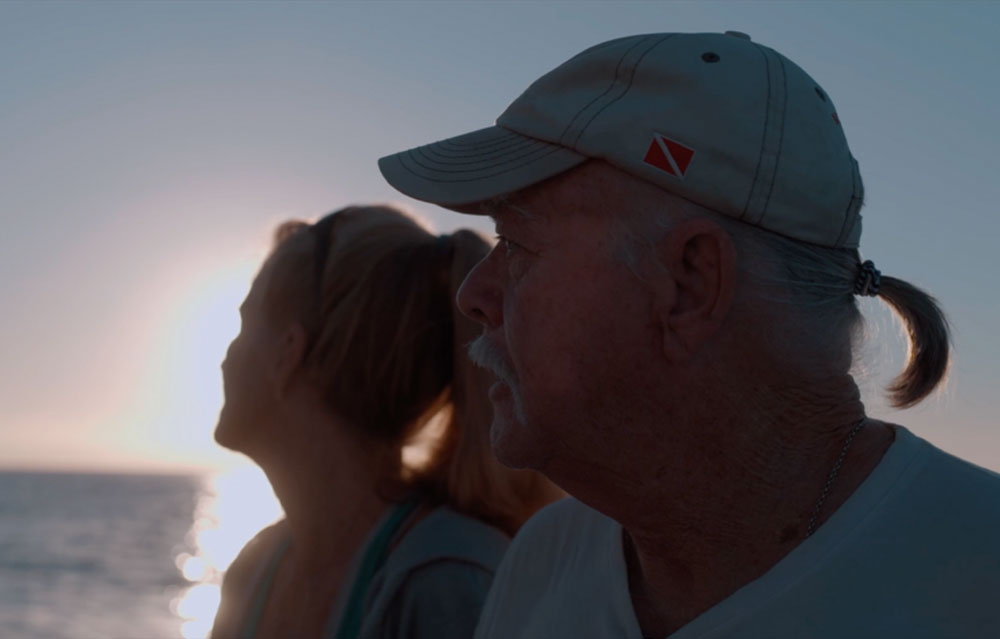Terry Kennedy has gone to some of the deepest places on earth as a scuba diver, but what may have been a little more harrowing was the thought of the deepest dive that’s ever been asked of him to tell his life story for the screen.
“To be able to see the entire documentary, I’m hanging on,” Kennedy laughs, a few days ahead of the premiere of “The Last Dive” at Tribeca. “I have not seen the entire film, but what I have seen, aside from my part in it, the footage was just awe inspiring and I’ve talked to enough people that have already seen it and they thought it was pretty darn good, which made me feel good.”
It is one plunge of many that you become glad Kennedy, who has stories to tell, yet hardly looks to be the first to talk about himself, has decided to take as director Cody Sheehy finds an unorthodox environmental hero in the diver who helped expose the threat to manta rays posed by overzealous fishermen in Baja Mexico where he has long gone to swim. Kennedy first began a love affair with the creatures in the early 1980s and over the course of an estimated 14,000 dives made friends with several specifically including one he nicknamed Willy, who he’d revisit time and again over the course of 19 years. Now in his eighties, Kennedy attempts to see Willie one last time in traveling to San Benedicto Island with his Dawn and Sheehy, after having lost touch with the manta ray when both tourists and fishermen became an increasing presence in the area.
The search for Willy reveals a master diver at work as it follows Kennedy and crew into the sea, but Sheehy has him dipping into treacherous waters as he recounts how he found purpose in his nautical pursuit after a restless youth that led him into enlisting in the Navy and ultimately starting a bar and hanging out with the Hell’s Angels. When his boat is named “Erotica,” it can be assumed that Kennedy never entirely left his wilder streak behind, yet swimming with different sharks than he once surrounded himself before, he can consider the calming effects that the water has had on him and Sheehy creates a similar effect when taking audiences beneath the surface in so many different ways as Kennedy looks back on his life’s accomplishments and ahead to a potential visit with Willy.
As Kennedy prepared himself to be among the hundreds to see “The Last Dive” for the first time at Tribeca, he and Sheehy spoke about how they first came to meet, bringing the experience of diving such great depths into cinemas and how they hope the film will make audiences conscious of the conservation efforts at its core.
How did this all come together?
Cody Sheehy: I’ve known Terry nine or 10 years now, and I’m a sailor too. We met out cruising around out there and we were anchored together. Terry took me under his wing and started scuba diving and showing me how to dive at the next level and I was hearing these stories. And then one day Terry started showing me all the footage that he had and all these incredible stories turned out to be totally true. As a filmmaker, I realized this is a great story. The world’s got to hear this.
Terry, were you immediately up for the idea of a full feature on your life?
Terry Kennedy: To say the least, it was interesting. [laughs] I’ve never been on camera like that before. And working with Cody, being out at the island, just made it all work out good for me. And watching Cody and his diving, he did really good. We just had just a great time.
Was the idea of reuniting with Willie, the manta ray, something that was in mind for a while or did it come about for the film?
Cody Sheehy: We were in hopes of seeing Willie when we went out there. And if he’s not feeding on the South end of the island, he’d have no idea we’re there. And when he does feed on the South end of the island, he probably recognizes us, especially if we’re in the water. But it’s hard for Terry to get out to the island nowadays. And it’s expensive. So once we started looking into this, realizing that some of these mantas that they’d not seen in say up to 32 years were showing up again for the scientists, it became really plausible that Willie could be there and we might be able to bring Terry back out there and reunite him again after this incredible friendship that they had. I thought it would just be extremely powerful in the film. Then it ended up sort of being the spine for the whole film as this journey to find him.
Terry Kennedy: Yeah, just the whole thing was a mind-blower for me when we actually were headed out there. I would say, “Wow, this is incredible. I’ll be able to see Willie again and stuff.” And as it turned out, we were a little premature in our efforts. We probably should have gone mid-January when all the humpbacks that come down from the Hawaiian Island chain, and we got there a little early. Even the humpbacks hadn’t shown up yet.
Was there anything important to you to capture about the experience of actually being out in the water?
Cody Sheehy: I just wanted to make sure that when people are watching this in the theater and it’s got awesome surround sound, and we could just capture what it really feels like to go in. The underwater [director of photography] Johnny Friday is a master of filming underwater and one of our goals was to just capture all the little details as best we can to try to recreate the experience, especially the experience of when the mantas arrive because they usually arrive about 20 minutes after you get in the water. So as best as we could, we wanted to recreate that experience of getting in the water, diving in this incredible landscape and it’s almost like cathedrals of rock around you. And then the mantas arrive, and suddenly when they show up, the ocean seems to go quiet, and there they are, and they just dominate your attention completely. That was my experience there and I wanted the audience to really feel and connect with the mantas, which are one of the most amazing animals on this planet.
Terry Kennedy: Going out to the islands is always major for me. I love it. We weren’t out there very long, and all of a sudden, one or two dive boats started showing up, which seemed a little bit early in the season, but they started showing up, and by the time it was over, we had like 12 large dive boats with anywhere between 18 and 20 divers on each boat. You can probably get an idea how much impact that was. The Boiler is one of my favorite dives, and it’s well-known worldwide. And if you’ve ever seen the Painted Desert, you get a single rock column that comes up from 135 feet to in 12 feet of the surface. It’s a cleaning station for the giant mantas, but it’s small. Can you imagine putting 20 or 30 divers on that? Oh, it’s pitiful. A little bit over-dived.
Cody Sheehy: That’s a major difference for Terry because when [he] spent a lot of your time out there, that level of diving pressure just didn’t exist back then. That must’ve been pretty shocking.
Terry Kennedy: It was. That’s why we went out early, honestly, was to avoid most of the boats. And even then, there were still a lot of them.
Cody Sheehy: Yeah, we got quite a surprise. Never saw that many divers out there, ever.
Terry Kennedy: It has to have some impact on the ecosystem, certainly on the mantas. I saw fewer of the mantas on the boiler than I used to. I used to see 10 or 12 of them. Now we saw, what, four or five?
Cody Sheehy: Two or three.
Terry Kennedy: And the ridge where we were going to dive and see the hammerhead sharks, I’ve got video footage. You probably see it with probably 200 hammerheads swimming above me and then just go right up into the school with a camera and swim right along with them. We saw a total of 10 hammers in 10 days. So there’s something going on there. I think it’s just a little bit over-dived.
What you’ve captured here is incredible. Beyond the fact that there’s all these tourists now, was there anything that happened that may have surprised you in telling this story?
Cody Sheehy: The tourism part was not going to be a major element in the story until that took over, so that’s definitely an area where it was unexpected. We also had no way to predict if we would find Willie or not, but it was really amazing when we found Chevy, who was also one of Terry’s old friends, and we also found Tippy, another [manta] that he knew. Those were really incredible moments to reconnect Terry with those old friends.
What’s it like getting to start sharing this with the world now?
Cody Sheehy: I just feel incredibly fortunate that it’s been noticed by Tribeca, and being accepted at Tribeca is going to bring awareness to the film, and that’s an incredible, incredible honor, and we’re really excited for that and all the other interest that we’re getting.
Terry Kennedy: Well, we haven’t seen the full movie yet. We’ve seen bits and pieces, and I must say I’ve seen a lot of documentaries, so not having not seen this whole documentary, what I’ve seen so far, I think Cody’s good at what he does. Very good. I was beyond impressed.
It looked like there’s already a plan to amplify the concerns about overcrowding in the ocean that you just mentioned in getting the film out to the public. What’s it been like putting together an impact campaign to raise awareness?
Cody Sheehy: Yeah, the impact campaign’s a big part of what we’re doing. We have two really major goals. One is to raise awareness and support for the science and conservation around mantas. We documented how a boat hit a manta and there is impact from overtourism. But on the other hand, without tourism, the fishing fleets would be in there fishing, and that would also be a huge threat, so it’s a nuanced situation and it [requires an] understanding that the tourism in those boats is why that provides an economic incentive for those islands to be protected from fishing, and fishing would not be good either, so we’ve just got to figure it all out.
And the other is to raise support and awareness around veterans and what we’ll kind of call “Blue Therapy,” which is something I didn’t really know about so much, but Terry’s story exemplifies it perfectly — just the idea that the ocean has this incredibly healing power. There’s a lot of partners that we’ve developed both in the conservation space and in the veterans space that are going to be showing this film to their members and using it to raise support for training veterans to be SCUBA certified and go out and experience some of what Terry’s able to do for them. Our goal is to just help as many people as possible go through that experience, and also bring as much support for the mantas as possible.
“The Last Dive” will screen again at the Tribeca Festival at AMC 19th St. East 6 on June 11th at 2:45 pm and June 12th at 5:15 pm.




